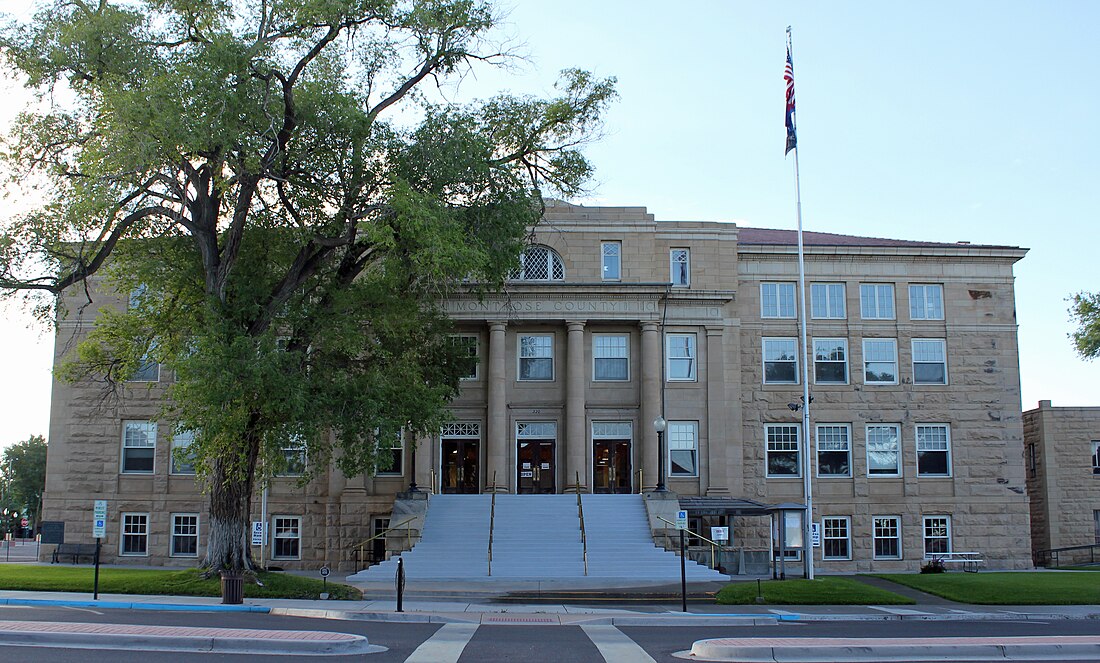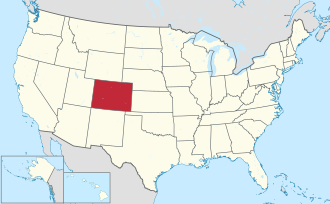Top Qs
Timeline
Chat
Perspective
Montrose County, Colorado
County in Colorado, United States From Wikipedia, the free encyclopedia
Remove ads
Montrose County is a county located in the U.S. state of Colorado. As of the 2020 census, the population was 42,679.[2] The county seat is Montrose,[3] for which the county is named.
Montrose County comprises the Montrose, CO, Micropolitan Statistical Area.[4][5]
Remove ads
Geography
Summarize
Perspective
According to the U.S. Census Bureau, the county has a total area of 2,243 square miles (5,810 km2), of which 2,241 square miles (5,800 km2) is land and 1.9 square miles (4.9 km2) (0.08%) is water.[6]
Adjacent counties
- Mesa County - north
- Delta County - northeast
- Gunnison County - east
- Ouray County - southeast
- San Miguel County - south
- San Juan County, Utah - west
Major highways
National protected areas
- Black Canyon of the Gunnison National Park
- Black Canyon of the Gunnison Wilderness
- Curecanti National Recreation Area (part)
- Dominguez-Escalante National Conservation Area (part)
- Gunnison Gorge National Conservation Area (part)
- Gunnison Gorge Wilderness
- Gunnison National Forest (part)
- Manti-La Sal National Forest (part)
- Old Spanish National Historic Trail
- Uncompahgre National Forest (part)
River
- Dolores River (part)
- Uncompahgre River (part)
- San Miguel River (part)
- Gunnison River (part)
Trails and byways
- Great Parks Bicycle Route
- Unaweep/Tabeguache Scenic and Historic Byway
- West Elk Loop Scenic Byway
- Western Express Bicycle Route
Historical site
Remove ads
Demographics
Summarize
Perspective
As of the census[12] of 2010, there were 41,276 people, 16,484 households, and 11,461 families residing in the county. The population density was 18 people per square mile (6.9 people/km2). There were 18,250 housing units at an average density of 8 units per square mile (3.1 units/km2). The racial makeup of the county was 86.70% White, 0.40% Black or African American, 1.10% Native American, 0.60% Asian, 0.10% Pacific Islander, 8.70% from other races, and 2.40% from two or more races. 19.70% of the population were Hispanic or Latino of any race.
There were 16,484 households, out of which 31.20% had children under the age of 18 living with them, 56.10% were married couples living together, 9.10% had a female householder with no husband present, and 30.50% were non-families. 25.80% of all households were made up of individuals, and 12.00% had someone living alone who was 65 years of age or older. The average household size was 2.47 and the average family size was 2.97.
The county population was spread out, with 24.70% under the age of 18, 6.40% from 18 to 24, 22.50% from 25 to 44, 28.60% from 45 to 64, and 17.80% who were 65 years of age or older. The median age was 42 years. For every 100 females there were 96.00 males. For every 100 females age 18 and over, there were 94.00 males.
Also from the census[13] of 2010, the median income for a household in the county was $46,058, and the median income for a family was $52,152. Males had a median income of $41,301 versus $31,659 for females. The per capita income for the county was $22,413. About 7.30% of families and 10.20% of the population were below the poverty line, including 13.40% of those under age 18 and 9.80% of those age 65 or over.
Remove ads
Politics
Summarize
Perspective
Montrose is a staunch Republican county. It has not been won by a Democratic presidential nominee since Lyndon Johnson‘s 1964 landslide – indeed since then, no Democrat has managed forty percent of the county's vote. The county has leaned Republican ever since 1920; although before this, it did tend to vote Democratic between 1896 and 1916 except during the landslide loss of Alton B. Parker in 1904.
In other offices, Montrose also is strongly Republican. The last Democratic Senatorial candidate it backed was Ben Nighthorse Campbell, who later shifted to the Republican Party, in the 1992 election.[15] Montrose County did back Constitution Party nominee Tom Tancredo in the 2010 gubernatorial election,[16] and Bill Ritter did win 46 percent in 2006,[17] but Roy Romer in 1990 remains the last Democratic candidate for governor to win Montrose County.[18]
Remove ads
Culture
Communities
City
Towns
Census-designated place
Other unincorporated places
See also
Notes
References
External links
Wikiwand - on
Seamless Wikipedia browsing. On steroids.
Remove ads



